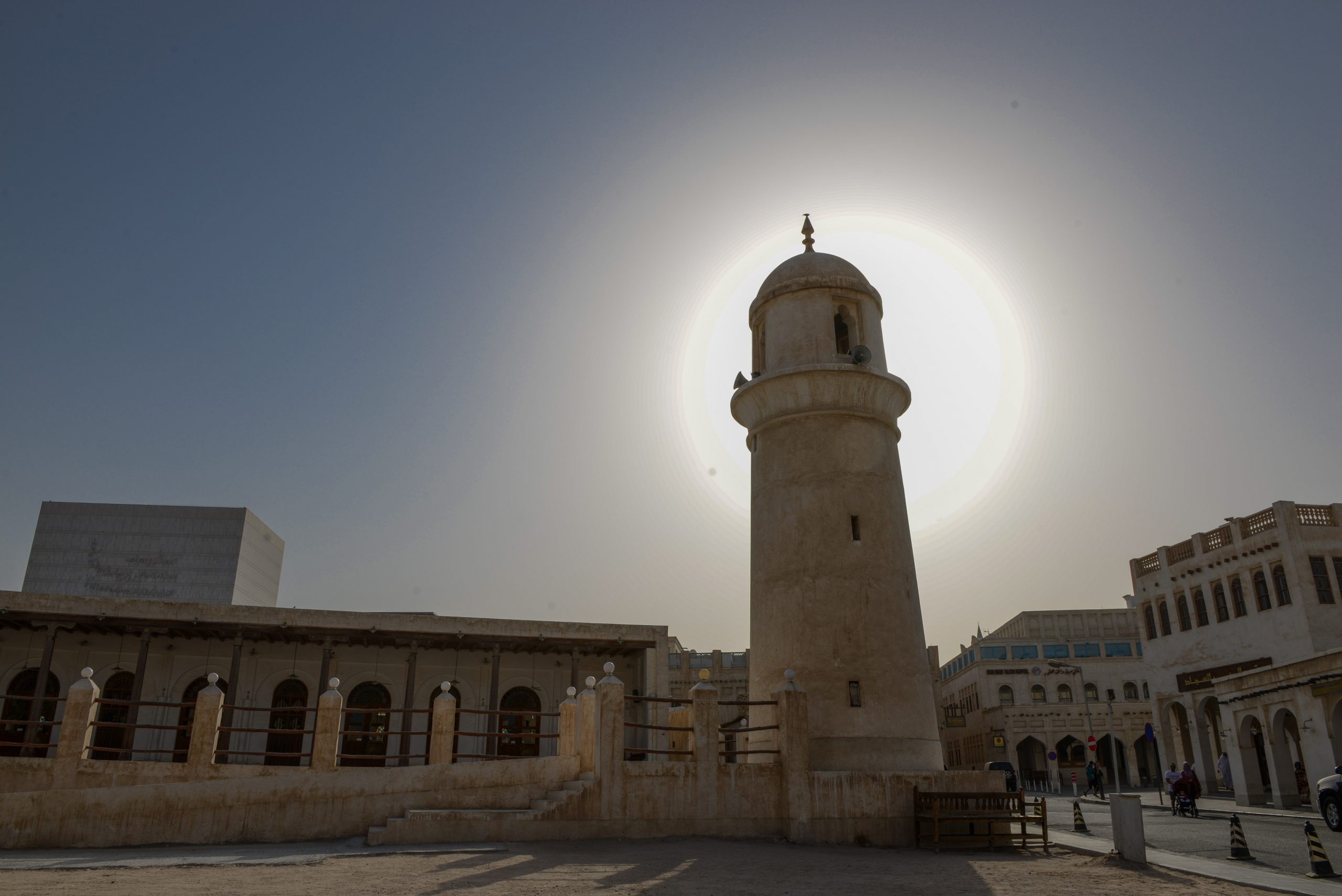A Look at Doha’s Al Qubaib Mosque
نظرة على مسجد القبيب في الدوحة
WGOQatar
Qatar, a nation known for its rapid modernization and impressive skyline, is also home to historical gems that reflect its rich architectural heritage. One such gem is Al Qubaib Mosque, also known as Sheikh Jassim bin Mohammed Al-Thani Mosque. This cultural landmark, nestled in the heart of Doha’s New Markets area, embodies the excellence of heritage architecture, blending structural strength with aesthetic beauty. In this article, we will explore the historical significance, architectural features, and preservation efforts that make Al Qubaib Mosque a beacon of Islamic heritage in Qatar.
- Name: Al Qubaib Mosque (Sheikh Jassim bin Mohammed Al-Thani Mosque)
- Location: Al Ahmad Street, New Markets area, Doha
- Built in: 1878
- Founder: Sheikh Jassim bin Mohammed bin Thani
- Architectural Style: Traditional Qatari mosque design of the 13th century AH (19th century AD)
- Area: Approximately 1,698 square meters
- Capacity: Accommodates nearly a thousand worshippers
Historical Significance:
- Constructed during the era of Sheikh Jassim bin Mohammed bin Thani, the founder of the modern State of Qatar.
- Reflects traditional Qatari mosque design from the 19th century.
- A prominent Islamic cultural landmark and a beacon of Islamic preaching.
Architectural Features:
- Roof covered by forty-four domes, an ancient architectural model.
- Unique use of domes to cover the roof of the mihrab.
- Open courtyard, four porticoes in the direction of the Qibla.
- Ablution area on the eastern side.
- Qibla canopy with 4 porticoes, mihrab, and stone pulpit.
- The main minaret in the southeastern corner with a ribbed dome and wooden crescent.
- Three smaller spiral minarets at other corners.
Preservation Efforts:
- Renovations and rebuilding in 1964, 1998, and 2012, maintaining the traditional heritage design.
- Use of environmentally friendly materials in line with Qatar’s heritage and sustainability vision.
- Restoration to correct structural specifications, prohibiting modern materials like concrete.
Al Qubaib Mosque stands as a testament to Qatar’s commitment to preserving its architectural heritage and traditional mosque design, reflecting the historical significance of this cultural landmark.
QNA
Doha: Al Qubaib Mosque, also known as Sheikh Jassim bin Mohammed Al-Thani Mosque, which is located on Al Ahmad Street in the New Markets area in Doha, is a cultural landmark that reflects the excellence of heritage architecture and the aesthetics that combines the strength of the structure and the beauty of the model.
In exclusive statements to Qatar News Agency (QNA) ), Engineer Mohammed Ali Abdullah and Dr. Mahmoud Ramadan, who are experts in antiquities, architecture and heritage, explained that the State of Qatar provided a model for preserving an authentic architectural tradition in the Arabian Peninsula and the Arabian Gulf, through rebuilding and restoring the Al Qubaib Mosque, adding that Qatar contributed to preserving it by using environmentally friendly materials, in line with Qatars vision of preserving heritage and sustainability.
The two experts praised the Mosque, which was built in 1878 in Doha, for retaining many important architectural elements that constitute the design style of traditional Qatari mosques in the 13th century AH and 19th century AD.
The construction of Al Qubaib Mosque dates back to the era of the late Sheikh Jassim bin Mohammed bin Thani, the founder of the modern State of Qatar (1878-1913 AD), who ordered its construction. Thus, it remains a prominent Islamic cultural landmark among the States landmarks and a beacon of Islamic preaching.
For his part, Engineer Mohammed Ali Abdullah, a heritage expert at the Private Engineering Office, confirmed in a statement to QNA that the State of Qatar provided a model for preserving an authentic architectural tradition in the Arabian Peninsula and the Arabian Gulf region, through rebuilding and restoring Al Qubaib Mosque, contributing to preserving an original style that was on the verge of disappearing.
He pointed out that building the roof of the Mosque with domes represents an ancient model in the region, noting that it is a method that was used in mosques only, not in homes and palaces, because domes are stronger in the face of climatic changes and the passage of time compared to wood. Whoever was responsible for building the mosque was keen to resist destruction to ensure the continuation of the good deeds of Sheikh Jassim bin Mohammed who chose in 1878 AD one of the best architects of his era to implement this model.
Engineer Mohammed Ali Abdullah stated that two mosques were built in this style, one of them in Doha and the other is in Sheikh Jassims residence in Al-Daayen when he settled there. Al Qubaib Mosque was a great, large building that could not be compared to any building on the coast of Doha in terms of size, the splendor of its forty four domes, or the strength of its construction.
The heritage expert at the Private Engineering Office stated that during the rainy seasons, the mud buildings would succumb to the winter rain and collapse, and people did not find a better refuge to shelter in than this Mosque, according to what was narrated by residents of Doha who lived through that period. He added that this Mosque remained standing until it was demolished to build a modern mosque in its place during the beginning of the sixties. The Mosque built of cement could not last more than 20 years, as cement began to fall from the ceiling. It was demolished and a mosque similar to the original one was build, but it differed from the old mosque in terms of its structural form and building materials. The forty-four domes stood on four and more concrete cement columns, while originally, each dome was supported by four columns. In 2009, it was decided to rebuild that edifice according to its correct and true structural specifications. The walls and the domes were made of stone and plaster, and the use of modern materials such as concrete was prohibited.
In turn, an expert in Islamic archaeology and architecture Dr. Mahmoud Ramadan highlighted in his QNA statement the historical significance of Al Qubaib Mosque, constructed in 1878 in Doha. Until recently, the mosque retained many important architectural elements that represent the traditional Qatari mosque design of the 13th Hijri (19th Century AD), characterized by an open courtyard, four porticoes in the direction of the Qibla and a rooftop dome supported by columns.
He emphasized that Al Qubaib Mosque’s architectural style showcases the ingenuity of the builders who used domes to cover the roof of the mihrab. This style, unique to the period, was the second architectural phase in the history of mosque construction in Qatar. Although some later mosques adopted used four porticoes in their planning like the Kaab ibn Zuhair Mosque in Al Wakrah from the late 20th century, they did not replicate the dome feature and added an additional prayer hall, resulting in a significant shift from the original style.
The mosque, including its external sanctuary, covers an area of approximately 1,698 square meters, accommodating nearly a thousand worshippers. Its walls, built of stone, feature rectangular doors on the northern and southern sides leading to the main open courtyard. The mosque’s main minaret occupies the southeastern corner of this courtyard, with the ablution area located on the eastern side, he explained.
The expert detailed that the qibla canopy is rectangular, consisting of 4 porticoes, the largest being the qibla arcade. This section of the mihrab is devoid of decoration, protruding externally from the wall. The mihrab leads to the stone pulpit and is flanked by sixteen windows, eight on each side. The one window on the left of the mihrab served as the imam’s entrance. The remaining porticoes are also rectangular covered by circular domes in the direction of the Qibla supported by columns.
Dr. Ramadan also mentioned that the mosque’s main minaret, located in the southeastern corner of the courtyard, features a stone base and a cylindrical structure with triangular windows at the top for light and ventilation, capped with a ribbed dome adorned with a wooden crescent. One can access the minaret via a stone staircase ascending from the courtyard. In addition to this main minaret, three smaller spiral minarets are positioned at the three other corners of the mosque.
Al Qubaib Mosque underwent renovations and rebuilding in 1964, 1998, and most recently in 2012, when it was reopened after being restored to its traditional heritage design as it stands today.
WGOQatar
قطر، البلاد المعروفة بتحولها السريع وأفقها المعماري المذهل، تحتضن أيضًا جواهر تاريخية تعكس تراثها المعماري الغني. أحدى هذه الجواهر هو مسجد القبيب، المعروف أيضًا بمسجد الشيخ جاسم بن محمد آل ثاني. هذا المعلم الحضاري، الموجود في قلب منطقة الأسواق الجديدة في الدوحة، يجسد تميز العمارة التراثية، حيث يجمع بين القوة البنائية وجمال الشكل. في هذا المقال، سنستكشف الأهمية التاريخية، والسمات المعمارية، وجهود الحفاظ التي تجعل مسجد القبيب منارة للتراث الإسلامي في قطر.
- الاسم: مسجد القبيب (مسجد الشيخ جاسم بن محمد آل ثاني)
- الموقع: شارع الأحمد، منطقة الأسواق الجديدة، الدوحة
- بُني في: 1878م
- المؤسس: الشيخ جاسم بن محمد بن ثاني
- النمط المعماري: تصميم مساجد قطر التقليدية من القرن الثالث عشر الهجري (التاسع عشر الميلادي)
- المساحة: حوالي 1698 متر مربع
- الاعتماد: يتسع لما يقارب ألف مصلٍ
أهمية تاريخية:
- بُني خلال عهد الشيخ جاسم بن محمد بن ثاني، مؤسس دولة قطر الحديثة.
- يعكس تصميم مساجد قطر التقليدية من القرن التاسع عشر.
ملامح معمارية:
- السقف مغطى بأربع وأربعين قبة، نموذج معماري قديم.
- استخدام فريد للقباب لتغطية سقف المحراب.
- صحن مكشوف، أربعة أروقة في اتجاه القبلة.
- منطقة الوضوء في الجانب الشرقي.
- ظلة القبلة تتكون من أربعة أروقة، محراب، ومنبر حجري.
- المئذنة الرئيسية في الزاوية الجنوبية الشرقية بقبة مفصصة.
جهود الحفاظ:
- تجديد وإعادة بناء في عام 1964، 1998، و2012 مع الحفاظ على التصميم التراثي.
- استخدام مواد صديقة للبيئة متوافقة مع رؤية قطر في الحفاظ على التراث والاستدامة.
- إعادة البناء وفق المواصفات الإنشائية الصحيحة مع منع استخدام المواد الحديثة مثل الخرسانة.
مسجد القبيب يعبر عن التزام قطر بالمحافظة على تراثها المعماري وتصميم المساجد التقليدية، مما يعكس الأهمية التاريخية لهذا المعلم الحضاري.




